
Make your own abacus
An abacus is a lot of fun to use. And you can make one very easily.
To make an abacus like the ones used long ago, you’ll need forty pebbles
and a piece of cardboard, wood, or stiff paper. With a ruler, draw three
lines on the board so that it is divided into four even columns. Then,
put ten pebbles, beans, buttons, or pennies in each column and your
abacus is ready to use. You’ll be able to work with numbers up to 9,999,
as shown a little farther on.
For a fancier abacus, you’ll need the materials listed below. The best
kind of box is a shoebox.
What you will need a box string beads or buttons scissors ruler

Making an abacus
With the ruler, measure and mark off four equally spaced marks on one
side of the box and four marks on the opposite side. The marks must line
up. Then punch a small hole in the box at each mark.
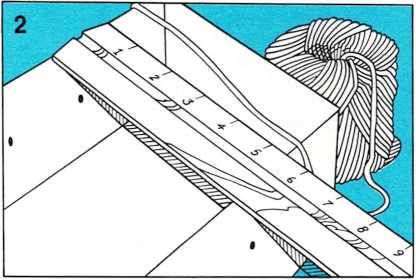
You are going to weave the thread in and out of all the holes, so you
will need a piece that is about six times as long as your box is wide.
With your ruler, measure the distance across the box, from a top hole to
a bottom hole. Cut off a piece of string about six times longer than the
distance you measured.
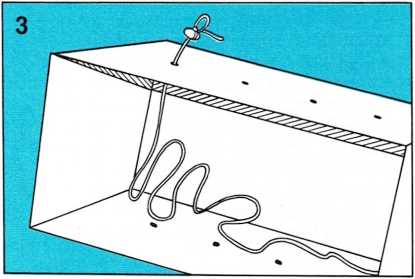
Tie a knot in one end of the string. Slip a bead onto the other end and
slide it down to the knot. Push the unknotted end of the string through
the first hole on the top left, from the outside to the inside of the
box. Pull the string through until the bead is tight against the outside
of the box.

Now slip ten beads onto the string. Push the free end of the string
through the opposite hole, from the inside to the outside of the box.
Pull the string tight. Then push the free end of the string through the
next hole, to the inside of the box. Slip ten more beads onto the
string. Push the end of the string through the hole on the opposite side
of the box. Pull the string tight.
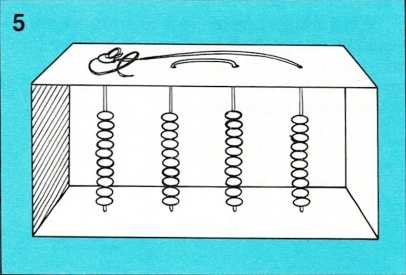
Continue threading the string through the holes and putting on beads
until you have pushed the end of the string through the last hole on the
right. The end of the string will now be on the same side of the box you
started from. Pull the string tight and wrap it underthe bead holding
the other end. Wrap it under the bead several times and tie a knot. With
the scissors, snip off any string that’s left dangling.
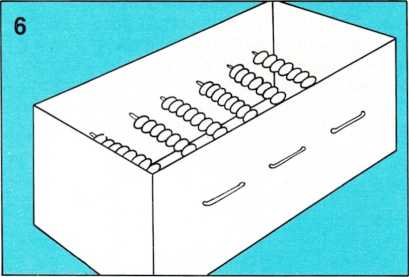
You are now ready to work problems with numbers up to 9,999. If you want
to work with larger numbers, all you have to do is add more strings of
beads. With one more string, you can work with numbers up to 99,999.
With two more strings, you can go up to 999,999.
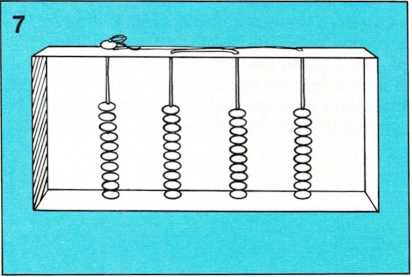
How to use an abacus
Working an abacus is easy, but there are a few things to remember. The
string on the right is the ones column. Each bead has a value of one
(1). The next string is the tens column. Each bead on this string has a
value of ten (10). The third string is the hundreds column, and each
bead has a value of one hundred (100). The last string, the one on the
left, is the thousands column. Each bead on this string has a value of
one thousand (1,000).
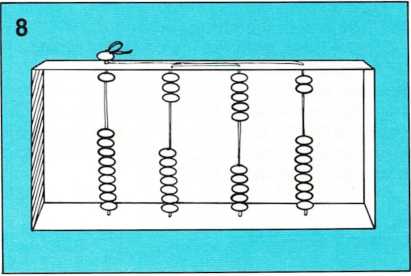
You start with all the beads at the bottom, towards you. As you work,
you push one or more beads to the top, away from you.
Suppose you want to show the number 1,352. Push up one bead in the
thousands column (1,000); push up three beads in the hundreds column
(300); push up five beads in the tens column (50); and push up two beads
in the ones column (2). You now have 1,000 + 300 + 50 + 2 or 1,352. Now,
let’s try some problems.
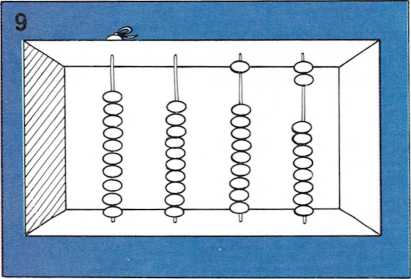
Doing addition on an abacus
Aciding on an abacus is quite simple. Start by pushing all the beads to
the bottom. Suppose you want to add 12 and 15. The number 12 is the same
as 10 and 2. So, push up one bead in the tens column. That’s your 10.
Then push up two beads in the ones column. That’s your 2.
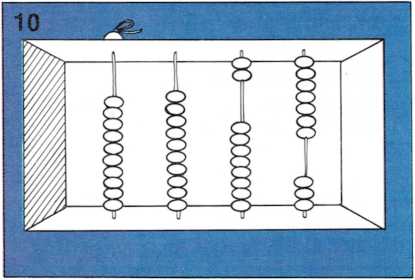
Now, you want to add 15, which is the same as 10 and 5. Push up one bead
in the tens column (10) and five beads in the ones column (5).
Now count the beads at the top of each column. There are two beads in
the tens column. That’s the same as 20. There are seven beads in the
ones column. That’s the same as 7. And 20 + 7 is 27. And if you write
out the problem, you\’ll see that 15 + 12 is also 27.

Let’s try another addition problem—one that’s a little harder. Suppose
you want to add 137 and 164. If you write out the problem, you’ll see
that the answer is 301. But let’s prove it on the abacus. Push all the
beads to the bottom and you are ready to go.
This time you push up 1 bead in the hundreds column (100), three beads
in the tens column (30) and seven beads in the ones column (7). You have
100 + 30 + 7, or 137.
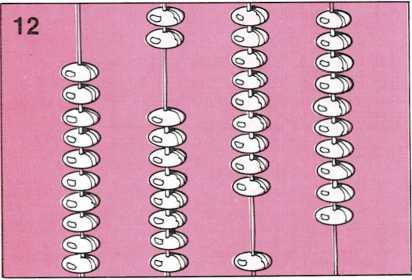
Now, let’s add 164 to 137. Push up one bead in the hundreds column
(100). Push up six beads in the tens column (60). Finally, push up four
beads in the ones column (4).
But wait a minute! You have only three beads left in the ones column.
You are one bead short. What happens now?
It’s very simple. Push up the three beads in the ones column. You now
have ten (10) in the ones column, so you can trade the ten ones for one
ten. This is the same as “carrying” in written addition.
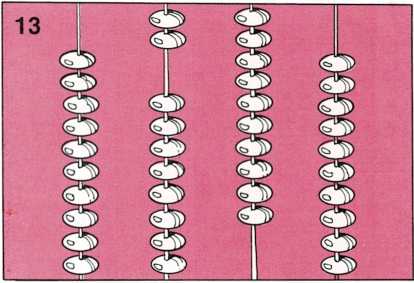
To make the trade, move the ten ones to the bottom and move one ten to
the top. You now have all your tens at the top and can make another
trade.
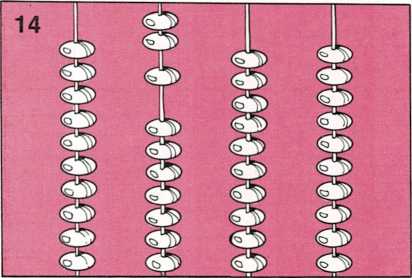
Move the ten tens to the bottom and move one of the beads in the
hundreds column to the top.
Hold on a minute. You’re not through yet. Don’t forget the one bead you
were short in the ones column that started all the trading.

You now have plenty of ones, so push one bead in the ones column to the
top.
Count your beads and you will see that you have three beads in the
hundreds column (300), no beads in the tens column (0), and one bead in
the ones column (1), or 301.
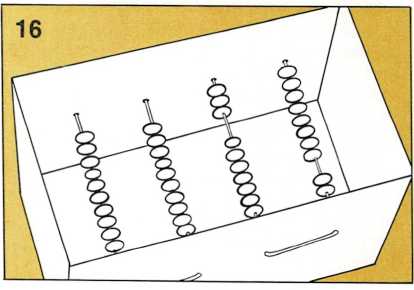
Doing subtraction on an abacus
You can subtract, or take away, on your abacus, too. Suppose you want to
take 13 from 38 (38—13). Push up three beads in the tens column (30)
and eight beads in the ones column (8). You now have 30 and 8, or 38.

You want to take 13 away. Now 13 is the same as 10 and 3. So take away
one of the beads in the tens column (10) and three of the beads in the
ones column (3).
You now have two tens (20) and five ones (5) left. And 20 and 5 is 25,
which is what you get when you subtract 13 from 38.
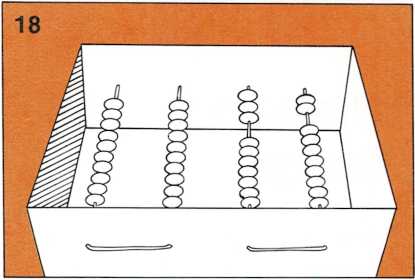
Now let’s try a subtraction problem in which you have to do some
trading.
Suppose you want to take 18 from 32. First, push all the beads to the
bottom. Set up the 32 by pushing up three tens (30) and two ones (2).

You want to take away 18, which is 10 and 8. So push one ten (10) down.
Now you want to push down eight ones (8). But you don’t have eight ones
at the top, only two. Push the two down. You still need six more. So
here is where you must trade. This is the same as “borrowing” in written
subtraction. All ten of your ones are now at the bottom, so you can
trade them for one ten. Push one ten down and push the ten ones to the
top, as shown.
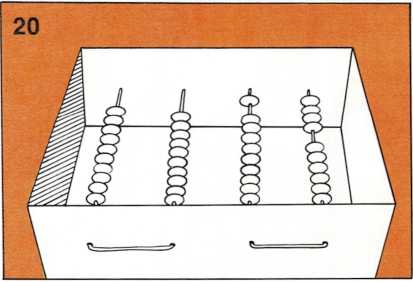
You can now push down the six ones you needed. Push them down. Your
abacus shows one ten (10) and four ones (4), or 14. And 18 from 32
leaves 14.
And that’s how you add and subtract on an abacus.
Now that you know how to use your abacus, try doing some other addition
and subtraction problems. You’ll be able to use any number up to 9,999.
Just remember to be careful when you have to borrow!
